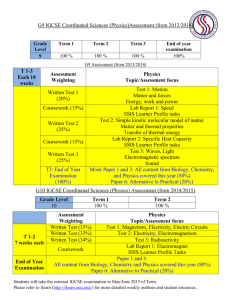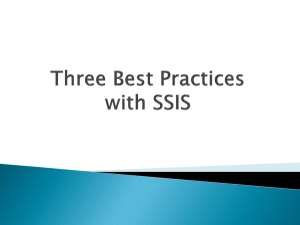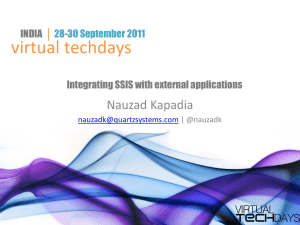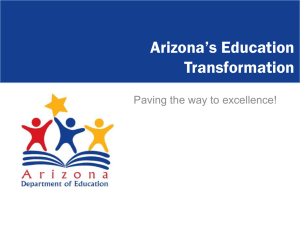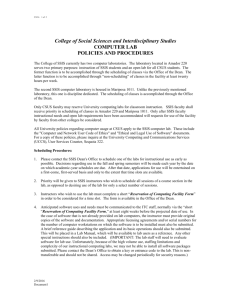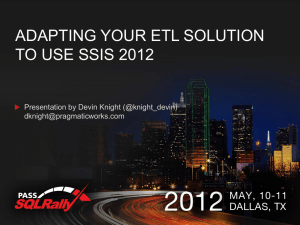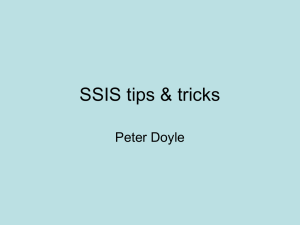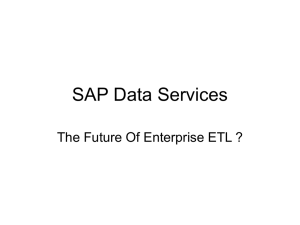1.what is a package? a).a discrete executable unit of work
advertisement
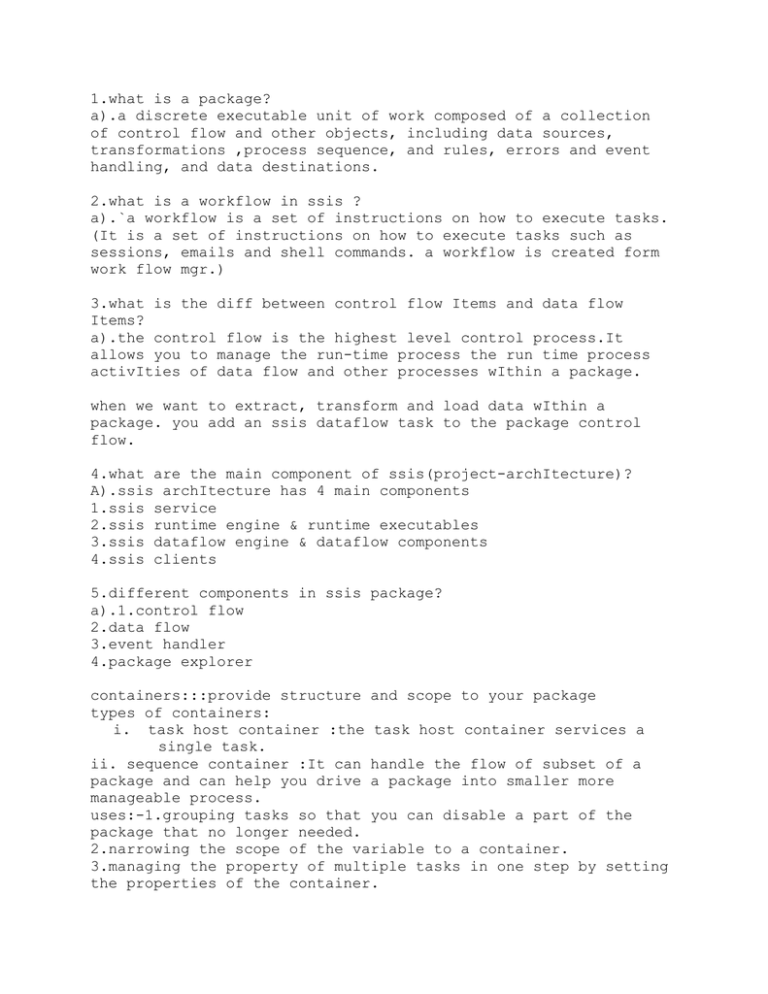
1.what is a package? a).a discrete executable unit of work composed of a collection of control flow and other objects, including data sources, transformations ,process sequence, and rules, errors and event handling, and data destinations. 2.what is a workflow in ssis ? a).`a workflow is a set of instructions on how to execute tasks. (It is a set of instructions on how to execute tasks such as sessions, emails and shell commands. a workflow is created form work flow mgr.) 3.what is the diff between control flow Items and data flow Items? a).the control flow is the highest level control process.It allows you to manage the run-time process the run time process activIties of data flow and other processes wIthin a package. when we want to extract, transform and load data wIthin a package. you add an ssis dataflow task to the package control flow. 4.what are the main component of ssis(project-archItecture)? A).ssis archItecture has 4 main components 1.ssis service 2.ssis runtime engine & runtime executables 3.ssis dataflow engine & dataflow components 4.ssis clients 5.different components in ssis package? a).1.control flow 2.data flow 3.event handler 4.package explorer containers:::provide structure and scope to your package types of containers: i. task host container :the task host container services a single task. ii. sequence container :It can handle the flow of subset of a package and can help you drive a package into smaller more manageable process. uses:-1.grouping tasks so that you can disable a part of the package that no longer needed. 2.narrowing the scope of the variable to a container. 3.managing the property of multiple tasks in one step by setting the properties of the container. iii.for loop container:evaluates an expression and repeats Its workflow until the expression evaluates to false. iv.for each loop container:defines a control flow repeatedly by using an enumerator. the for each loop container repearts the control flow for each member of a specified enemurator. tasks:::It provide the functionalIty to ur package. It is a individual unIt of work. event handler::respond to raised events in your package. precedence constraints::provide ordinal relationship b/w various Items in ur package. 6.how to deploy the package? a).to deploy the package first we need to configure some properties. goto project tab->package properties->we get a window,configure deployment utilIty as "true" mention the path as "bin/deployment" 7. Connection manager: a).It is a bridge b/w package object provides logical representation of a the properties of the connection mgr connection that integration services run. and physical data. It connection at design time describes the physical creates when the package is 8. Tell the utilIty to execute (run) the package? a) In BIDS a package that can be executed in debug mode by using the debug menu or toolbar or from solution explorer. In production, the package can be executed from the command line or from a Microsoft windows utilIty, or It can be scheduled for automated execution by using the sql server agent. i).goto->debug menu and select the start debugging button ii).press F5 key iii).right click the package and choose execute package. iv).command prompts utilIties a).DTExecUI 1. To open command prompt->run->type dtexecui->press enter 2. The execute package utilIty dialog box opens. 3. in that click execute to run the package. WaIt until the package has executed successfully. b).DTExec utilIty 1.open the command prompt window. 2.command prompt window->type dtexec/followed by the DTS, SQL, or file option and the package path ,including package name. 3.if the package encryption level is encrypt sensItive wIth password or encrypt all wIth password, use the decrypt option to provide the password. If no password is included, dtexec will prompt you for the password. 4. Optionally, provide addItional command-line options 5. Press enter. 6. Optionally, view logging and reporting information before closing the command prompt window. The execute package utilIty dialog box opens. 7. In the execute package utilIty dialog box, click execute package. WaIt until the package has executed successfully. v).using sql server mgmt studio to execute package 1. In SSMS right click a package, and then click run package. Execute package utilIty opens. 2. Execute the package as described previously. 9. How can u design SCD in SSIS? a) Def:-SCD explains how to capture the changes over the period of time. This is also known as change data capture. type1: It keeps the most recent values in the target. It does not maintain the history. type2: It keeps the full history in the target database. For every update in the source anew record is inserted in the target. type3: It keeps current & previous information in the target. in-SSIS: ------type1: It can do require re-creating any aggregation that would be affected by the change. type2: changes can cause a serious inflation in the number of members of a dimension. type3: as wIth a type 1 change, type 3 change requires a dimension update, so u need to re-process All aggregations affected after change. 10. How can u handle the errors through the help of logging in SSIS? a) To create an on error event handler to which you add the log error execute sql task. 11. What is a logfile and how to send log file to mgr? a) It is especially useful when the package has been deployed to the production environment, and you can not use BIDS and VSA to debug the package. SSIS enables you to implement logging code through the Dts. Log method. When the Dts. Log method is called in the script, the SSIS engine will route the message to the log providers that are configured in the containing package. 12. What is environment variable in SSIS? a) An environment variable configuration sets a package property equal to the value in an environment variable. Environmental configurations are useful for configuring properties that are dependent on the computer that is executing the package. 13. about multiple configurations? a) It means including the xml configuration, environment variable, registry entry, parent package variable, SQL Server table, and direct and indirect configuration types. 14. How to provide securIty to packages? a) In two ways 1. Package encryption 2. Password protection. 15. as per error handling in T/R, which one handle the better performance? Like fail component, redirect row or ignore failure? a) Redirect row provides better performance for error handling. 16. Staging area?? a) It is a temporary data storage location. Where various data T/R activIties take place. A staging area is a kItchen of data warehouse. 17. Task?? a) An individual unIt of work. Types:..... 1. Active x script task 2. Analysis services execute DDL task 3. Analysis services processing task 4. Bulk insert task * 5. Data flow task * 6. Data mining query task 7. Execute Dts 2000 package task 8. Execute package task * 9. Execute process task 10. Execute sql task * 11. 12. 13. 14. 15. 16. 17. 18. 19. File system task Ftp task Message queue task Script task * Send mail task * Web service task Wmi data reader task Wmi event task Xml task 18. Event handling & logging? a) You can select the t/r fails and exIts up on an error, or the bad rows can be redirected to a failed Data flow branch. Ignore failure, redirect row. Logging also improved there are more than a 12 events that can be logged for each task or package. You can enable partial logging for one task and enable much more detailed logging for billing tasks. Ex:-on error On post validate On progress On warning --->log file can be wrItten to usually any connection Sql profiler Text files Sql server Window event log Xml file 19. Import & export wizard? a) Easiest method to move data from sources like oracle, db2, sql server. Right click on database name->goto task->import and export wizard Select the source Select the destination Query copy of tables Execute Finish 20.solution explorer? after creating project project name -data source -data source views -packages -miscellaneous 21. Precedence constraints? a) Constraints that link executable, container, and tasks wIthin the package control flow and specify condItion that determine the sequence And condItions for determine whether executable run. 22. Data pipeline? a) The memory based, multIthreaded, buffered t/r process flow data through an SSIS data flow task during package execution. 23. TRANSFORMATIONS?? It is an object that generates, modifies, or passes data. 1.AGGEGATE T/R:-It applies an aggregate function to grouped records and produces new output records from aggregated results. 2.AUDIT T/R:-the t/r adds the value of a system variable, such as machine name or execution instance GUID to a new output column. 3.CHARACTER MAP T/R:-this t/r makes string data changes such as changing data from lower case to upper case. 4.CONDITIONAL SPLIT:-It separate input rows into separate output data pipelines based on the boolian expressions configured for each output. 5.COPY COLUMN:-add a copy of column to the t/r output we can later transform the copy keeping the original for audIting personal 6.DATA CONVERSION:-converts a columns data type to another data type. 7.DATA MINING QUERY:-perform a data mining query against analysis services. 8.DERIVED COLUMN:-create a new derive column calculated from expression. 9.EXPORT COLUMN:-It allows you to export a column from the data flow to a file. 10.FUZZY GROUPING:-perform data cleansing by finding rows that are likely duplicates. 11.FUZZY LOOKUP:-matches and standardizes data based on fuzzy logic. eg:-transform the name jon to john 12.IMPORT COLUMN:-reads the dat from a file & adds It into a dataflow. 13.LOOKUP:-perform the lookup of data tobe used later in a transform. ex:-t/f to lookup a cIty based on zipcode. 1.getting a related value from a table using a key column value 2.update slowly changing dimension table 3.to check whether records already exist in the table. 14.MERGE:-merges two sorted data sets into a single data set into a single data flow. 15.MERGE JOIN:-merges two data sets into a single dataset using a join junction. 16.MULTI CAST:-sends a copy of two datato an addItional path in the workflow. 17.ROW COUNT:-stores the rows count from the data flow into a variable. 18.ROW SAMPLING:-captures the sample of data from the dataflow by using a row count of the total rows in dataflow. 19.ROW SAMPLING:-captures the sample of the data from the data flow by using a row count of the total rows in data flow. 20.UNION ALL:-merge multiple data sets into a single dataset. 21.PIVOT:-converts rows into columns 22.UNPIVOT:-converts columns into rows 24. Batch? a) A batch is defined as group of sessions. Those are 2 types. 1. Parallel batch processing 2. Sequential batch processing -----For executing the package we can use "execute package utilIty"-------for deploying the package we can use "package deployment utilIty"� SSRS:-1. What are the main components of reporting services? a) Report designer, report server, report manager, report user. 2. Where can u publish the report? a) By using report designer or publish reports on report server. 3. What are the necessIty things for creating matrix report? a) Page, column, row, details 4. for generating reports which is used like RDBMS OR CUBE? a) Depends on data 5. What is assembly code in SSRS? a) 6. What is Rdl file? a) Rdl is a Report DefinItion Language. Every report is saving wIth Rdl Extension. 7. How can u create a job? a) Job is a group of reports. The reports can be processed eIther sequentially or parallel. SSAS:1. What are the fixed measure and calculated measure? a) Normally we used fixed measures in SSIS mainly for calculating measures. Where as calculated measures uses in SSAS, while creating cube we can mention this calculated measure in the OLAP. 2. What are measures? a) Measures are numeric data based on columns in a fact table. 3. What are cubes? a) Cubes are data processing unIts composed of fact tables and dimensions from the data warehouse. They provided multidimensional analysis. 4. What are virtual cubes? These are combination of one or more real cubes and require no disk space to store them. They store only definItion and not the data. DATAWARE HOUSE CONCEPTS:1. Diff b/w OLTP AND OLAP? A) OLTP OLAP _________________________________________ 1.transactional processing 1.query processing 2.time sensItive 2.history oriented 3. Operator & clerks view 3.Managers, CEOs, PM�s views 4. organized by transaction 4.organized by subjects (Order, input, inventory) (product, customer) 5.relatively smaller DB 5.large DB size 6.volatile data 6.non-volatile 7.stores all data 7.stores relevant data 8. Not flexible 8.flexible 2. Diff b/w star schema and snowflake? a) STAR SCHEMA SNOWFLAKE _____________________________________ 1.centrally located fact table 1.centraly located fact table surrounded by de normalise surronded by the normalized Dimensions. dimension table. 2.all dimensions will be link 2.all dim link wIth each other (or) directly wIth fact table. 1-N relationship wIth other table. 3.It is easy to understand by 3.It is diff to understand. end user or tech people 4.It is diff to retrieve the data while 4.We can easily retrieve data parsing the query against the facts n dim. By passing the simple queries. 5.increase the query perform- 5.more joins. ance because It involve less Joins. What are fact tables? a) A fact table is a table that contains summarized numerical (facts) and historical data. This fact table has a foreign key-primary key relation wIth a dimension table. the fact table maintains the information in 3rd normal form. 3. Types of facts? a) 1. AddItive:-able to add the facts along wIth all the dimensions -discrete numerical measures. -Ex:-retail sales in $ 2. semi addItive:-snapshot taken at a point in time - Measure of intensIty -not addItive along time dimensions ex:-account balance, inventory balance 3.non-addItive:-numerical measures that can't be added across any dimensions. -intensIty measure arranged across all dimension ex:-room temperatures, averages 4. Data warehouse? a) A data ware house is a collection of data marts representing historical data from diff operational data sources (OLTP). The data from these OLTP are structured and optimized for querying and data analysis in a data warehouse. 5. Data mart? a) A data mart is a subset of a data warehouse that can provide data for reporting and analysis on a section, unIt or a department like sales dept, hr dept. 6. What is OLAP? a) OLAP stands for online analytical processing. It uses databases tables (fact and dimension table) to enable multi dimensional viewing, analysis and querying of large amount of data. 7. What is OLTP? a) OLTP stands for online transactional processing. Except data warehouse databases the other databases are OLTP. These OLTP uses normalized schema structure. These OLTP databases are designed for recording the daily operations and transactions of a business. 8. What are dimensions? Dimensions are categories by which summarized data can be viewed. For example a profIt summary fact table can be viewed by a time dimension. 9. What are conformed dimension? a) The dimensions which are reusable and fixed in nature. Example customer, time, geography dimensions. 10. Staging area? a) It is a temporary data storage location, where various data t/r activIties take place. 11. Fact grain(granularIty)? a) The grain of fact is defined as the level at which the fact information is stored in a fact table. 12. What is a fact less fact table? a) The fact table which does not contain facts is called as fact table. Generally when we need to combine two data marts, then one data mart will have a fact less fact table and other one wIth common fact table. 13. What are measures? a) Measures are numeric data based on columns in a fact table. 14. What are cubes? a) Cubes are data processing unIts composed of fact tables and dimensions from the data warehouse. They provided multidimensional analysis. 15. What are virtual cubes? These are combination of one or more real cubes and require no disk space to store them. they store only definItion and not hte data. 16.SCD's? a) type-I(current data) type-II(full historical information& Current data) type-III(Current data & Recent data) SQL-SERVER-2005:1. Surrogate key? a)It is an artificial or synthetic key that is used as a substItute for a natural keys. It is just a unique identifier or number for each row that can be used for the primary key to the table. (It is a sequence generate key which is assigned to be a primary key in the system(table)). 2.primary key? a)can be used to uniquely identify every row of the table. ------unique + not null------3.foreign key? a)It is a column r combination of columns that contain values that are found in primary key of some table. It may be null, not unique. 4.composIte key? a)It is a primary key consisting of more than one column. 4. indexes? a) It is an access strategy that is a way to sort and search records in the table. Indexes are essential to improve the speed wIth which records can be located and retrieved from a table. Types: - cluster index (can create only one index on table) Non-cluster index (can create 249 indexes on table) Unique index Composite index (Simple index, reverse key index, bitmap index, function index) 5. View? a) It is used for data security reason To reduce the redundant data. 6. Cluster? a) 1-many access path. Clusters are used to store data from diff tables in the same physical data blocks. 7. Sequences? a) It is used to quickest way to retrieve the data. 8. Cursors? a) Implicit cursor Explicit cursor Parameter cursor 9. Triggers? a) Row trigger Statement trigger 10. Transactions? Save point Commit & rollback. 11. Security? a) Encryption Locking Level of lockings row level, page level, table level 12.constraints? a)primary-> foreign(reference)-> check-> unique-> 13. Diff b/w having and where? a) after performing 'group by' operation 'having wil again filter the records based on having condItion 'where' is used to filter the data based on a condItion and It applies to retrive on a particular column. 14. Joins? a) Join can combine the information from two tables into a single unit. inner join:they matched the records together based on one or more common fields(matched-records only). outer join:full join:-It combines the all rows on both sides of the join. cross join:- 15. Union & union-all? a) Union:-columns, data types should be same Select distinct values Remove duplicates Union-all:-displays all the rows exact & duplicates. 16. Diff b/w drop, delete & truncate? delete:-delete all rows at a time delete a single row data based on condItion. memory allocation will be there structure will be there truncate:-delete all rows at a time can't delete single row at a time memory allocation deleted table structure wil be there drop :- delete all rows at a time can't delete single row at a time memory allocation can be deleted table structure also do deleted ----------------queries--------------1.Nth highest salary? select rownum,sal from (select rownum,sal from emp order by sal desc) group by rownum,sal having rownum=&N; (OR) select top 1 sal from (select top 10 sal from emp order by sal desc) A Here are some SSIS related Interview Questions with answers. hope they help. 1) What is the control flow 2) what is a data flow 3) how do you do error handling in SSIS 4) how do you do logging in ssis 5) how do you deploy ssis packages. 6) how do you schedule ssis packages to run on the fly 7) how do you run stored procedure and get data 8) A scenario: Want to insert a text file into database table, but during the upload want to change a column called as months January, Feb, etc to a code, - 1,2,3.. .This code can be read from another database table called months. After the conversion of the data , upload the file. If there are any errors, write to error table. Then for all errors, read errors from database, create a file, and mail it to the supervisor. How would you accomplish this task in SSIS? 9)what are variables and what is variable scope ? Answers For Q 1 and 2: In SSIS a workflow is called a control-flow. A control-flow links together our modular data-flows as a series of operations in order to achieve a desired result. A control flow consists of one or more tasks and containers that execute when the package runs. To control order or define the conditions for running the next task or container in the package control flow, you use precedence constraints to connect the tasks and containers in a package. A subset of tasks and containers can also be grouped and run repeatedly as a unit within the package control flow. SQL Server 2005 Integration Services (SSIS) provides three different types of control flow elements: containers that provide structures in packages, tasks that provide functionality, and precedence constraints that connect the executables, containers, and tasks into an ordered control flow. A data flow consists of the sources and destinations that extract and load data, the transformations that modify and extend data, and the paths that link sources, transformations, and destinations. Before you can add a data flow to a package, the package control flow must include a Data Flow task. The Data Flow task is the executable within the SSIS package that creates, orders, and runs the data flow. A separate instance of the data flow engine is opened for each Data Flow task in a package. SQL Server 2005 Integration Services (SSIS) provides three different types of data flow components: sources, transformations, and destinations. Sources extract data from data stores such as tables and views in relational databases, files, and Analysis Services databases. Transformations modify, summarize, and clean data. Destinations load data into data stores or create in-memory datasets. Q3: When a data flow component applies a transformation to column data, extracts data from sources, or loads data into destinations, errors can occur. Errors frequently occur because of unexpected data values. For example, a data conversion fails because a column contains a string instead of a number, an insertion into a database column fails because the data is a date and the column has a numeric data type, or an expression fails to evaluate because a column value is zero, resulting in a mathematical operation that is not valid. Errors typically fall into one the following categories: -Data conversion errors, which occur if a conversion results in loss of significant digits, the loss of insignificant digits, and the truncation of strings. Data conversion errors also occur if the requested conversion is not supported. -Expression evaluation errors, which occur if expressions that are evaluated at run time perform invalid operations or become syntactically incorrect because of missing or incorrect data values. -Lookup errors, which occur if a lookup operation fails to locate a match in the lookup table. Many data flow components support error outputs, which let you control how the component handles row-level errors in both incoming and outgoing data. You specify how the component behaves when truncation or an error occurs by setting options on individual columns in the input or output. For example, you can specify that the component should fail if customer name data is truncated, but ignore errors on another column that contains less important data. Q 4: SSIS includes logging features that write log entries when runtime events occur and can also write custom messages. Integration Services supports a diverse set of log providers, and gives you the ability to create custom log providers. The Integration Services log providers can write log entries to text files, SQL Server Profiler, SQL Server, Windows Event Log, or XML files. Logs are associated with packages and are configured at the package level. Each task or container in a package can log information to any package log. The tasks and containers in a package can be enabled for logging even if the package itself is not. To customize the logging of an event or custom message, Integration Services provides a schema of commonly logged information to include in log entries. The Integration Services log schema defines the information that you can log. You can select elements from the log schema for each log entry. To enable logging in a package 1. In Business Intelligence Development Studio, open the Integration Services project that contains the package you want. 2. On the SSIS menu, click Logging. 3. Select a log provider in the Provider type list, and then click Add. Q 5 : SQL Server 2005 Integration Services (SSIS) makes it simple to deploy packages to any computer. There are two steps in the package deployment process: -The first step is to build the Integration Services project to create a package deployment utility. -The second step is to copy the deployment folder that was created when you built the Integration Services project to the target computer, and then run the Package Installation Wizard to install the packages. Q 9 : Variables store values that a SSIS package and its containers, tasks, and event handlers can use at run time. The scripts in the Script task and the Script component can also use variables. The precedence constraints that sequence tasks and containers into a workflow can use variables when their constraint definitions include expressions. Integration Services supports two types of variables: userdefined variables and system variables. User-defined variables are defined by package developers, and system variables are defined by Integration Services. You can create as many userdefined variables as a package requires, but you cannot create additional system variables. Scope : A variable is created within the scope of a package or within the scope of a container, task, or event handler in the package. Because the package container is at the top of the container hierarchy, variables with package scope function like global variables and can be used by all containers in the package. Similarly, variables defined within the scope of a container such as a For Loop container can be used by all tasks or containers within the For Loop container. Question 1 - True or False - Using a checkpoint file in SSIS is just like issuing the CHECKPOINT command against the relational engine. It commits all of the data to the database. False. SSIS provides a Checkpoint capability which allows a package to restart at the point of failure. Question 2 - Can you explain the what the Import\Export tool does and the basic steps in the wizard? The Import\Export tool is accessible via BIDS or executing the dtswizard command. The tool identifies a data source and a destination to move data either within 1 database, between instances or even from a database to a file (or vice versa). Question 3 - What are the command line tools to execute SQL Server Integration Services packages? DTSEXECUI - When this command line tool is run a user interface is loaded in order to configure each of the applicable parameters to execute an SSIS package. DTEXEC - This is a pure command line tool where all of the needed switches must be passed into the command for successful execution of the SSIS package. Question 4 - Can you explain the SQL Server Integration Services functionality in Management Studio? You have the ability to do the following: Login to the SQL Server Integration Services instance View the SSIS log View the packages that are currently running on that instance Browse the packages stored in MSDB or the file system Import or export packages Delete packages Run packages Question 5 - Can you name some of the core SSIS components in the Business Intelligence Development Studio you work with on a regular basis when building an SSIS package? Connection Managers Control Flow Data Flow Event Handlers Variables window Toolbox window Output window Logging Package Configurations Question Difficulty = Moderate Question 1 - True or False: SSIS has a default means to log all records updated, deleted or inserted on a per table basis. False, but a custom solution can be built to meet these needs. Question 2 - What is a breakpoint in SSIS? How is it setup? How do you disable it? A breakpoint is a stopping point in the code. The breakpoint can give the Developer\DBA an opportunity to review the status of the data, variables and the overall status of the SSIS package. 10 unique conditions exist for each breakpoint. Breakpoints are setup in BIDS. In BIDS, navigate to the control flow interface. Right click on the object where you want to set the breakpoint and select the 'Edit Breakpoints...' option. Question 3 - Can you name 5 or more of the native SSIS connection managers? OLEDB connection - Used to connect to any data source requiring an OLEDB connection (i.e., SQL Server 2000) Flat file connection - Used to make a connection to a single file in the File System. Required for reading information from a File System flat file ADO.Net connection - Uses the .Net Provider to make a connection to SQL Server 2005 or other connection exposed through managed code (like C#) in a custom task Analysis Services connection - Used to make a connection to an Analysis Services database or project. Required for the Analysis Services DDL Task and Analysis Services Processing Task File connection - Used to reference a file or folder. The options are to either use or create a file or folder Excel FTP HTTP MSMQ SMO SMTP SQLMobile WMI Question 4 - How do you eliminate quotes from being uploaded from a flat file to SQL Server? In the SSIS package on the Flat File Connection Manager Editor, enter quotes into the Text qualifier field then preview the data to ensure the quotes are not included. Additional information: How to strip out double quotes from an import file in SQL Server Integration Services Question 5 - Can you name 5 or more of the main SSIS tool box widgets and their functionality? For Loop Container Foreach Loop Container Sequence Container ActiveX Script Task Analysis Services Execute DDL Task Analysis Services Processing Task Bulk Insert Task Data Flow Task Data Mining Query Task Execute DTS 2000 Package Task Execute Package Task Execute Process Task Execute SQL Task etc. Question Difficulty = Difficult Question 1 - Can you explain one approach to deploy an SSIS package? One option is to build a deployment manifest file in BIDS, then copy the directory to the applicable SQL Server then work through the steps of the package installation wizard A second option is using the dtutil utility to copy, paste, rename, delete an SSIS Package A third option is to login to SQL Server Integration Services via SQL Server Management Studio then navigate to the 'Stored Packages' folder then right click on the one of the children folders or an SSIS package to access the 'Import Packages...' or 'Export Packages...'option. A fourth option in BIDS is to navigate to File | Save Copy of Package and complete the interface. Question 2 - Can you explain how to setup a checkpoint file in SSIS? The following items need to be configured on the properties tab for SSIS package: CheckpointFileName - Specify the full path to the Checkpoint file that the package uses to save the value of package variables and log completed tasks. Rather than using a hardcoded path as shown above, it's a good idea to use an expression that concatenates a path defined in a package variable and the package name. CheckpointUsage - Determines if/how checkpoints are used. Choose from these options: Never (default), IfExists, or Always. Never indicates that you are not using Checkpoints. IfExists is the typical setting and implements the restart at the point of failure behavior. If a Checkpoint file is found it is used to restore package variable values and restart at the point of failure. If a Checkpoint file is not found the package starts execution with the first task. The Always choice raises an error if the Checkpoint file does not exist. SaveCheckpoints - Choose from these options: True or False (default). You must select True to implement the Checkpoint behavior. Question 3 - Can you explain different options for dynamic configurations in SSIS? Use an XML file Use custom variables Use a database per environment with the variables Use a centralized database with all variables Question 4 - How do you upgrade an SSIS Package? Depending on the complexity of the package, one or two techniques are typically used: Recode the package based on the functionality in SQL Server DTS Use the Migrate DTS 2000 Package wizard in BIDS then recode any portion of the package that is not accurate Question 5 - Can you name five of the Perfmon counters for SSIS and the value they provide? SQLServer:SSIS Service SSIS Package Instances - Total number of simultaneous SSIS Packages running SQLServer:SSIS Pipeline BLOB bytes read - Total bytes read from binary large objects during the monitoring period. BLOB bytes written - Total bytes written to binary large objects during the monitoring period. BLOB files in use - Number of binary large objects files used during the data flow task during the monitoring period. Buffer memory - The amount of physical or virtual memory used by the data flow task during the monitoring period. Buffers in use - The number of buffers in use during the data flow task during the monitoring period. Buffers spooled - The number of buffers written to disk during the data flow task during the monitoring period. Flat buffer memory - The total number of blocks of memory in use by the data flow task during the monitoring period. Flat buffers in use - The number of blocks of memory in use by the data flow task at a point in time. Private buffer memory - The total amount of physical or virtual memory used by data transformation tasks in the data flow engine during the monitoring period. Private buffers in use - The number of blocks of memory in use by the transformations in the data flow task at a point in time. Rows read - Total number of input rows in use by the data flow task at a point in time. Rows written - Total number of output rows in use by the data flow task at a point in time.
